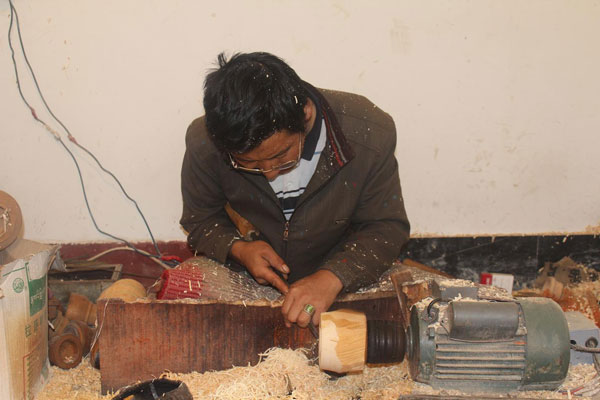
Photo shows a Menba craftsman works on a wooden bowl.[Photo/China Tibet Online]
![Photo shows a Menba craftsman works on a wooden bowl.[Photo/China Tibet Online]](./W020110714783913791113.jpg)
Photo shows a Menba craftsman works on a wooden bowl.[Photo/China Tibet Online]
Is there anything that a person can use throughout his life?
Few, except for human organs. However, the answer is positive when it comes to the Menbas, an ethnic minority dwelling in southwest China's Tibet Autonomous Region.
But what is it that Menbas use all their life?
It is finely designed and handmade wooden bowls, which users consider as their life companions.
Less than 10,000 people in Menba ethnic group now live in China. Menbas have their own spoken language, but they understand and write in Tibetan language. Legend goes that the Menba ancestors lived in the Himalayas area in the southern part of Tibet.
The Menba ethnic group boasts a long history of culture and agriculture, yet their most well-known craftsmanship is the making of fine wooden bowls.
Conventionally, wooden bowls are made of tung, mulberry or birchen trunks. Five or six procedures are required for the making of exquisite wooden bowls which are evenly textured and well cut. Some are coated with paint.
The wooden bowls are usually dewatered before the actual production process, so the bowls will be less probable to be out of shape when filled with hot water or tea.
Also the bowls are light to carry, which is more convenient for herders and travelers in old times.
It is said that the best wooden bowls are made in Ma Ma Village, a village that is historically respected as "hometown of wooden bowls".
Nowadays, Ma Ma villagers are encouraged to make bowls for arts and crafts, which are favorite of many domestic and foreign visitors. And making wooden bowls has become an important way of income increase for local dwellers.
Gam Tsering, 29 year-old inheritor of the wooden bowl craftsmanship, who received special training funded by the village committee, can make around 3000 yuan per month.
With increasingly varied demand, craftsmen today have more patterns designed and more kinds of utensils made, such as wooden cups, containers, snuff boxes, etc.
![Photo shows a Menba craftsman works on a wooden bowl.[Photo/China Tibet Online]](./W020110714783913798388.jpg)
Photo shows a Menba craftsman works on a wooden bowl.[Photo/China Tibet Online]
![Photo shows a Menba craftsman works on a wooden bowl.[Photo/China Tibet Online]](./W020110714783913796829.jpg)
Photo shows a Menba craftsman works on a wooden bowl.[Photo/China Tibet Online]
